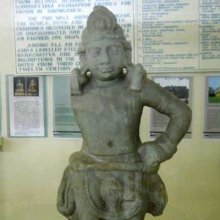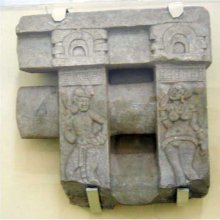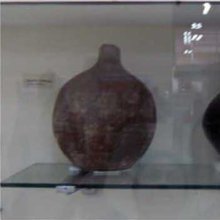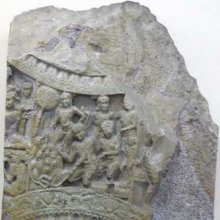Amaravati, Amarāvati, Amarāvatī, Amaravatī: 28 definitions
Introduction:
Amaravati means something in Buddhism, Pali, Hinduism, Sanskrit, Jainism, Prakrit, the history of ancient India, Marathi, Tamil. If you want to know the exact meaning, history, etymology or English translation of this term then check out the descriptions on this page. Add your comment or reference to a book if you want to contribute to this summary article.
Images (photo gallery)
(+120 more images available)
In Hinduism
Vaishnavism (Vaishava dharma)
Source: ISKCON Press: GlossaryAmarāvatī (अमरावती).—The capital city of Lord Indra's heavenly abode. It has the power of greatly extending the life span of its residents.
Source: Pure Bhakti: Brhad BhagavatamrtamAmarāvatī (अमरावती) refers to:—City of pleasure, Indra’s capital city in Svarga. (cf. Glossary page from Śrī Bṛhad-bhāgavatāmṛta).

Vaishnava (वैष्णव, vaiṣṇava) or vaishnavism (vaiṣṇavism) represents a tradition of Hinduism worshipping Vishnu as the supreme Lord. Similar to the Shaktism and Shaivism traditions, Vaishnavism also developed as an individual movement, famous for its exposition of the dashavatara (‘ten avatars of Vishnu’).
Purana and Itihasa (epic history)
Source: Wisdom Library: Varāha-purāṇaAmarāvatī (अमरावती) is the city city of Indra, guardian (dikpāla) of the eastern direction, according to the Varāhapurāṇa chapter 76.
Source: archive.org: Shiva Purana - English TranslationAmarāvatī (अमरावती) refers to the “capital of Indra” (supposed to be situated on Mount Meru), according to the Śiva-purāṇa 3.18.2-3: “Formerly Indra and other gods defeated by the Asuras left their capital Amarāvatī due to fear. The gods harrassed by the Daityas went to Kaśyapa. Highly agitated, they bowed down to him with palms joined and shoulders drooping”.
Note: Amarāvatī is the mythical capital of Indra’s heaven, situated on the golden mount Meru. It is famous for its greatness and splendour. Amarāvatī is called Devapura, ‘city of gods’ and Pūṣābhāsā, ‘sun-splendour’ and by various other names.
Source: archive.org: Puranic EncyclopediaAmarāvatī (अमरावती).—It is the city of Indra, the King of the Devas. Its location is described in Devī Bhāgavata as follows: "Brahmā’s world extends over 10,000 yojanas on the Mahāmeru mountain. There are eight cities-each 2,500 square yojanas in extent—of the Aṣṭadikpālakas in eight parts of this Brahmapurī. Thus there are nine cities on the top of the Mahā Meru. They are the following:—
In the centre is Brahmā’s city, Manovatī.
To the east of Manovatī, Indra’s city, Amarāvatī.
In the south-east corner, Agni’s city, Tejovatī.
On the southern side, Yama’s city, Saṃyamanī.
In the south-west corner, Nirrti’s city, Kṛṣṇāñjanā.
In the west, Varuṇa’s city, Śraddhāvatī.
In the north-west corner, Vāyu’s city, Gandhavatī.
In the north, Kubera’s city Mahodaya.
In the north-east corner, Śiva’s city, Yaśovatī. (Devī Bhāgavata, Aṣṭama Skandha).
Source: Cologne Digital Sanskrit Dictionaries: The Purana IndexAmarāvatī (अमरावती).—Heaven noted for the pleasure-park Nandana. A description of the city, occupied for some time by Bali.1 Though it was really the capital of Indra, the latter says that it belonged to Kṛṣṇa.2 When it is midday here, the sun rises at Samyamana.3
- 1) Bhāgavata-purāṇa VIII. 15. 11-22 and 33; Vāyu-purāṇa 77. 26.
- 2) Bhāgavata-purāṇa X. [67 (V) 26]; Viṣṇu-purāṇa I. 9. 25.
- 3) Brahmāṇḍa-purāṇa II. 21. 37; III. 13. 26 and 30; Matsya-purāṇa 124. 27.
Amarāvatī (अमरावती) is a name mentioned in the Mahābhārata (cf. III.164.42, III.170.25) and represents one of the many proper names used for people and places. Note: The Mahābhārata (mentioning Amarāvatī) is a Sanskrit epic poem consisting of 100,000 ślokas (metrical verses) and is over 2000 years old.

The Purana (पुराण, purāṇas) refers to Sanskrit literature preserving ancient India’s vast cultural history, including historical legends, religious ceremonies, various arts and sciences. The eighteen mahapuranas total over 400,000 shlokas (metrical couplets) and date to at least several centuries BCE.
Shaivism (Shaiva philosophy)
Source: Wisdom Library: ŚaivismAmarāvatī (अमरावती) refers to the city of Indra, situated on the eastern lower slope of mount Meru, according to Parākhyatantra 5.66. Meru is the name of a golden mountained situated in the middle of nine landmasses (navakhaṇḍa): Bhārata, Hari, Kimpuruṣa, Ramyaka, Ramaṇa, Kuru, Bhadrāśva, Ketumāla and Ilāvṛta. Together these khaṇḍas make up the continent known as Jambūdvīpa.
Amarāvatī is also known by the name Amara and is mentioned in various other sources, eg., the Svacchanda-tantra 10.132-136, Kiraṇa-āgama 8.51-54, Mṛgendra-āgama vidyāpāda 13.47-54, Sarvajñānottara-tantra adhvaprakaraṇa 34-36 and Mataṅga-āgama vidyāpāda 23.60-63
The Parākhyatantra is an old Śaiva-siddhānta tantra dating from before the 10th century.

Shaiva (शैव, śaiva) or Shaivism (śaivism) represents a tradition of Hinduism worshiping Shiva as the supreme being. Closely related to Shaktism, Shaiva literature includes a range of scriptures, including Tantras, while the root of this tradition may be traced back to the ancient Vedas.
General definition (in Hinduism)
Source: Wisdom Library: HinduismAmarāvati (अमरावति, “immortality”):—The name of the city where Indira resides. Indra is the king of the gods. He is the ruler of the storm and represents the all-pervading electric energy. As a major deity in the Ṛg-veda, he also represents the cause of fertility.
Source: WikiPedia: HinduismAmarāvati (अमरावती): The city of Indra
In Buddhism
Theravada (major branch of Buddhism)
Source: Pali Kanon: Pali Proper Names1. Amaravati - Also called Amara. A city in the time of Dipankara Buddha. Sumedha was born there in a very rich family and renounced the world after having given his wealth away (Bu.ii.5; J.i.6; DhA.i.83, etc.). According to the Mahabodhivamsa (p.2) the city was so called because it was inhabited by men like gods.
2. Amaravati - A city in the time of Kondanna Buddha eighteen leagues in extent. It was in the Devavana, near the city, that Kondanna preached his first sermon (v.l. Arundhavati). BuA.108-9.
3. Amaravati - The city of Sakka, king of the gods. Sp.i.49; Cv.lxxx.5; it is described in the Mahabharata iii.1714ff.; see also Hopkins, Epic Mythology, 140f.
Theravāda is a major branch of Buddhism having the the Pali canon (tipitaka) as their canonical literature, which includes the vinaya-pitaka (monastic rules), the sutta-pitaka (Buddhist sermons) and the abhidhamma-pitaka (philosophy and psychology).
In Jainism
General definition (in Jainism)
Source: archive.org: TrisastisalakapurusacaritraAmarāvatī (अमरावती) refers to the capitals of the Nāgas and the Gods, according to chapter 2.1 [ajitanātha-caritra] of Hemacandra’s 11th century Triṣaṣṭiśalākāpuruṣacaritra: an ancient Sanskrit epic poem narrating the history and legends of sixty-three illustrious persons in Jainism.
Accordingly, “in this province there (i.e., Vatsa) is a famous city, suitably named Susīmā (Well-bounded), a depository of wealth, resembling a tilaka on the earth. [...] It (the city) was just like the sole meeting-place for pleasure of love, wealth, and duty at the same time, like friends. Because of its great wealth the city was like a sister between the cities Bhogāvatī below and Amarāvatī above”.

Jainism is an Indian religion of Dharma whose doctrine revolves around harmlessness (ahimsa) towards every living being. The two major branches (Digambara and Svetambara) of Jainism stimulate self-control (or, shramana, ‘self-reliance’) and spiritual development through a path of peace for the soul to progess to the ultimate goal.
India history and geography
Source: Google Books: Shifting Stones, Shaping the PastAmarāvatī (अमरावती) is a relatively recent name for this site and its environs. The ancient name, Dhānyakaṭaka and its variant Dharanikoṭa, appears in numerous inscriptions. Perhaps the earliest reference to Dhānyakaṭaka appears on a pillar with several narratives, now in the Amarāvatī Site Museum. Along with several episodes from the life of the Buddha, the pillar in question, dated to the first century BCE, includes a depiction of a village scene and a river, which is labeled “Dhamnakada.”
Source: Eastern Calukyas: Administration and Culture (buddhism)Amaravatī (अमरवती) was a great centre of Buddhism. An inscription from Amaravati, dated Ś. 1102, states that “there isa city named Dhānyakaṭaka..., where god Buddha, worshipped by the creator, is quite close, (and) where (there is) a very lofty Caitya, well decorated with various sculptures”. The great Caitya, mentioned here, seems to be identical with the famous Amaravatī-stupa.
Source: Ancient Buddhist Texts: Geography of Early BuddhismAmarāvatī (अमरावती) is the name of a locality situated in Dakkhiṇāpatha (Deccan) or “southern district” of ancient India, as recorded in the Pāli Buddhist texts (detailing the geography of ancient India as it was known in to Early Buddhism).—In the Dhammapadaṭṭhakathā, there is a reference to the city of Amarāvatī. It is stated that the Buddha in one of his previous births as a Brahmin youth named Sumedha was born in that city. It is identical with modern city of Amaraoti close to the rivers of Dharanikotta (a mile west of ancient Amarāvatī on the Kriṣṇa famous for its ruined stūpa).
Source: Shodhganga: The significance of the mūla-beras (history)Amaravati was during the Satavahana dynasty (200 BC) an important region where now artificats (metal images) have been found.—The Satavahanas who ruled in the Deccan and the South had a long reign of about 400 years (circa 200 BC to AD 200). The fine workmanship of the carvers reveals the high standard of efficiency of these craftsmen. The metal images found at Buddham, Amaravati, Kolhapur show the high watermark of metal work in the Satavahana period. The Ikshvakus succeeded the Satavahanas towards the end of the 2nd century AD and they were great patrons of art. The metal work of their period was equally good as their stone carving.

The history of India traces the identification of countries, villages, towns and other regions of India, as well as mythology, zoology, royal dynasties, rulers, tribes, local festivities and traditions and regional languages. Ancient India enjoyed religious freedom and encourages the path of Dharma, a concept common to Buddhism, Hinduism, and Jainism.
Languages of India and abroad
Marathi-English dictionary
Source: DDSA: The Molesworth Marathi and English Dictionaryamarāvatī (अमरावती).—f (S) The name of Indra's capital in Swarga.
Source: DDSA: The Aryabhusan school dictionary, Marathi-Englishamarāvatī (अमरावती).—f The name of indra's capital in svarga.
Marathi is an Indo-European language having over 70 million native speakers people in (predominantly) Maharashtra India. Marathi, like many other Indo-Aryan languages, evolved from early forms of Prakrit, which itself is a subset of Sanskrit, one of the most ancient languages of the world.
Sanskrit dictionary
Source: DDSA: The practical Sanskrit-English dictionaryAmarāvatī (अमरावती).—[amara-vat, ra being changed to rā by P. VI.3.119]
1) Abode of the gods, residence of Indra (said to be above Meru or the sun's orb; cf. Kirātārjunīya 7;2); ससंभ्रमेन्द्रद्रुतपातितार्गला निमीलिताक्षीव भियाऽमरावती (sasaṃbhramendradrutapātitārgalā nimīlitākṣīva bhiyā'marāvatī) K. P.1.
2) Name of a modern town in Berar, Amaravati.
Source: Cologne Digital Sanskrit Dictionaries: Shabda-Sagara Sanskrit-English DictionaryAmarāvatī (अमरावती).—f. (-tī) The capital of Indra. E. amara a deity, and matup aff.
Source: Cologne Digital Sanskrit Dictionaries: Benfey Sanskrit-English DictionaryAmarāvatī (अमरावती).—i. e. amara + vant + ī. The capital of Indra, [Rāmāyaṇa] 3, 53, 37.
Source: Cologne Digital Sanskrit Dictionaries: Cappeller Sanskrit-English DictionaryAmarāvatī (अमरावती).—[feminine] [Name] of Indra's capital.
Source: Cologne Digital Sanskrit Dictionaries: Monier-Williams Sanskrit-English Dictionary1) Amarāvatī (अमरावती):—[=amarā-vatī] [from a-mara > a-mamri] f. (cf. [Pāṇini 6-3, 119]), ‘the abode of the immortals’, Indra’s residence, [Mahābhārata; Harivaṃśa etc.]
2) [v.s. ...] Name of a town in Berar.
Source: Cologne Digital Sanskrit Dictionaries: Yates Sanskrit-English DictionaryAmarāvatī (अमरावती):—[amarā+vatī] (tī) 3. f. Indra’s capital; the heaven of the gods.
[Sanskrit to German]
Sanskrit, also spelled संस्कृतम् (saṃskṛtam), is an ancient language of India commonly seen as the grandmother of the Indo-European language family (even English!). Closely allied with Prakrit and Pali, Sanskrit is more exhaustive in both grammar and terms and has the most extensive collection of literature in the world, greatly surpassing its sister-languages Greek and Latin.
Kannada-English dictionary
Source: Alar: Kannada-English corpusAmarāvati (ಅಮರಾವತಿ):—
1) [noun] the capital city of the region of the gods; the city of Indra.
2) [noun] (fig.) any place or city of great beauty and pleasure.
3) [noun] a particular breed of cattle, the male of which has a very strong built up.
4) [noun] a variety in red gram (Cajanus indicus).
Kannada is a Dravidian language (as opposed to the Indo-European language family) mainly spoken in the southwestern region of India.
See also (Relevant definitions)
Ends with: Ponamaravati.
Full-text (+133): Mahendranagari, Svargapuri, Svarnagari, Shurapura, Ashvatthanagara, Dhanyakataka, Amara, Vrishabhasa, Surapuri, Devapur, Arundhavati, Mahendra, Siladhara, Indranagari, Acalapura, Dhanyakata, Virapura, Dhanyaghata, Dhanyaghataka, Indrapura.
Relevant text
Search found 87 books and stories containing Amaravati, Amarāvati, Amarāvatī, Amaravatī, Amara-vati, Amarā-vatī; (plurals include: Amaravatis, Amarāvatis, Amarāvatīs, Amaravatīs, vatis, vatīs). You can also click to the full overview containing English textual excerpts. Below are direct links for the most relevant articles:
Brihad Bhagavatamrita (commentary) (by Śrī Śrīmad Bhaktivedānta Nārāyana Gosvāmī Mahārāja)
Verse 1.2.22 < [Chapter 2 - Divya (the celestial plane)]
Verse 2.2.27 < [Chapter 2 - Jñāna (knowledge)]
Amaravati Art in the Context of Andhra Archaeology (by Sreyashi Ray chowdhuri)
Chapter 1 - Scope, Sources and Methodology
The Great Departure or Mahābhiniṣkramaṇa < [Chapter 3 - Amarāvatī and the Formative Stage of the Buddhist Art]
Pūrṇakalaśa (the symbol of abundance) < [Chapter 3 - Amarāvatī and the Formative Stage of the Buddhist Art]
Garga Samhita (English) (by Danavir Goswami)
Verses 1.7.24-26 < [Chapter 7 - Description of the Conquest of All Directions]
Verse 1.7.27 < [Chapter 7 - Description of the Conquest of All Directions]
Verse 6.7.44 < [Chapter 7 - The Marriage of Śrī Rukmiṇī]
The Skanda Purana (by G. V. Tagare)
Chapter 230 - Vṛka’s Conquest of Indra’s Kingdom < [Section 1 - Tīrtha-māhātmya]
Chapter 46 - The Genesis of the Name Amarāvatī < [Section 1 - Avantīkṣetra-māhātmya]
Chapter 161 - The Greatness of Sarpa Tīrtha < [Section 3 - Revā-khaṇḍa]
The Great Chronicle of Buddhas (by Ven. Mingun Sayadaw)
Part 4 - The Name Amaravatī < [Chapter 1-3 - Anudīpanī on words and phrases]
Chapter 3 - Sumedha the Brahmin < [Volume 1.1]
Chapter 4 - Renunciaton of Sumedha < [Volume 1.1]
Maha Prajnaparamita Sastra (by Gelongma Karma Migme Chödrön)
Part 9 - Ṣaḍdanta-jātaka < [Chapter XX - The Virtue of Generosity and Generosity of the Dharma]
The Śaśa-Jātaka < [I. Puṇyakriyāvastu consisting of generosity]
Appendix 1 - The story of Nanda (the half-brother of the Buddha) < [Chapter IV - Explanation of the Word Bhagavat]
Related products







